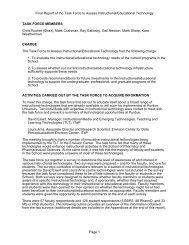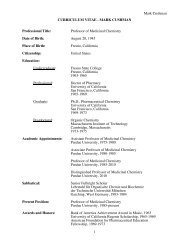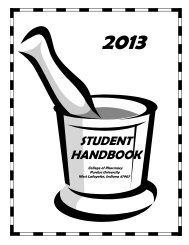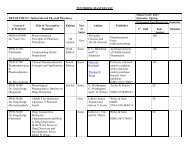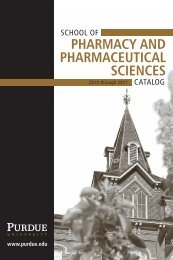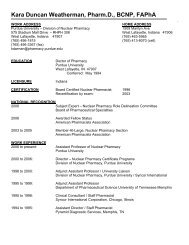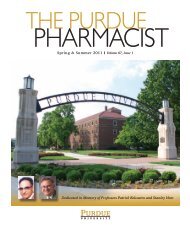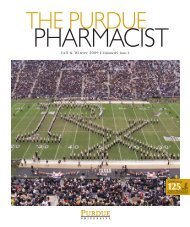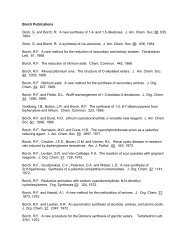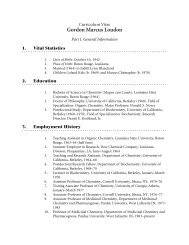Spring 2007 - Purdue College of Pharmacy - Purdue University
Spring 2007 - Purdue College of Pharmacy - Purdue University
Spring 2007 - Purdue College of Pharmacy - Purdue University
Create successful ePaper yourself
Turn your PDF publications into a flip-book with our unique Google optimized e-Paper software.
Teaching Students<br />
About the NIH Grant Process<br />
Pr<strong>of</strong>essor Don Bergstrom participates in an extremely popular<br />
course that teaches graduate students about grant writing. “The<br />
goal <strong>of</strong> the course is to teach students how to write an NIH style<br />
grant proposal,” he says. “During the course, we talk about the<br />
mechanics <strong>of</strong> a grant proposal, and we have various pr<strong>of</strong>essors<br />
talk about their own experiences and give different perspectives<br />
to the process.” Students must then write a proposal and serve<br />
on a mock study section.<br />
<strong>Pharmacy</strong> faculty who have participated in the course include<br />
Drs. Bob Geahlen, Marc Loudon, Dave Nichols, and Carol Post.<br />
Since each <strong>of</strong> them has served on NIH study sections, they are<br />
able to speak first-hand about how grants are reviewed.<br />
“There is also a session on ethics where we discuss that there<br />
are many ways that people can be dishonest in science, be it<br />
plagiarism or fake results. We talk about these pitfalls and how<br />
to avoid them during the course,” comments Bergstrom.<br />
The students are graded on three assignments during the<br />
course. First, students are divided into several teams <strong>of</strong> three<br />
and have 10 days to write a three-page proposal which combines<br />
all <strong>of</strong> their own research, thus teaching the students how<br />
to work together and forcing them to combine ideas. Next,<br />
students write a 15-page NIH style grant proposal. They are<br />
provided with all <strong>of</strong> the necessary background information on<br />
how to construct a grant and have the opportunity to review<br />
examples. Two weeks prior to the end <strong>of</strong> the semester, they turn<br />
in their proposals. The final assignment begins with Dr. Bergstrom<br />
assigning each student to a study section with specific<br />
roles (as primary and secondary reviewer, and as reader), and<br />
the students then have ten days to review their three proposals.<br />
It is, however, strongly advised that the students read all <strong>of</strong> the<br />
proposals in their study section (8-12 proposals total). Since<br />
only primary and secondary reviewers are required to provide<br />
written critiques, each student thus is responsible for two written<br />
critiques and must be prepared to discuss a third (as the reader)<br />
during the study section. The process mimics the NIH process<br />
exactly. There are four sessions which consist <strong>of</strong> these themes:<br />
Medicinal Chemistry and Chemical Biology, Biochemistry and<br />
Structural Biology, Cell Signaling, and Molecular Pharmacology.<br />
The last Saturday <strong>of</strong> the semester, the course holds a study<br />
section which lasts the entire day with two sections meeting<br />
simultaneously in the morning and afternoon with lunch<br />
provided. The reviewers present their critiques and the group<br />
discusses each proposal, spending roughly 3-4 hours for each<br />
section. “By listening and participating, the students learn<br />
a great deal about what they should and shouldn’t include<br />
in a proposal,” says Bergstrom.<br />
This course, now titled MCMP 625, began well before 1989<br />
when Dr. Bergstrom arrived at <strong>Purdue</strong>. The content <strong>of</strong> the course<br />
has changed since then and now involves more structure and<br />
more involvement by the faculty. Once a temporary course, the<br />
<strong>University</strong> has approved it as a formal course now <strong>of</strong>fered in<br />
both the fall and spring semesters. It is capped at 40 students,<br />
and typically there are 35-40 students enrolled each semester,<br />
including students outside <strong>of</strong> pharmacy.<br />
Dr. Bergstrom comments that he once had a former student<br />
return from a job interview explaining how she was <strong>of</strong>fered the<br />
position because she already had the most experience in writing<br />
grant proposals. That student clearly benefited from having<br />
participated in this grant writing course.<br />
the PURDUE pharmacist n SPRING <strong>2007</strong><br />
3




